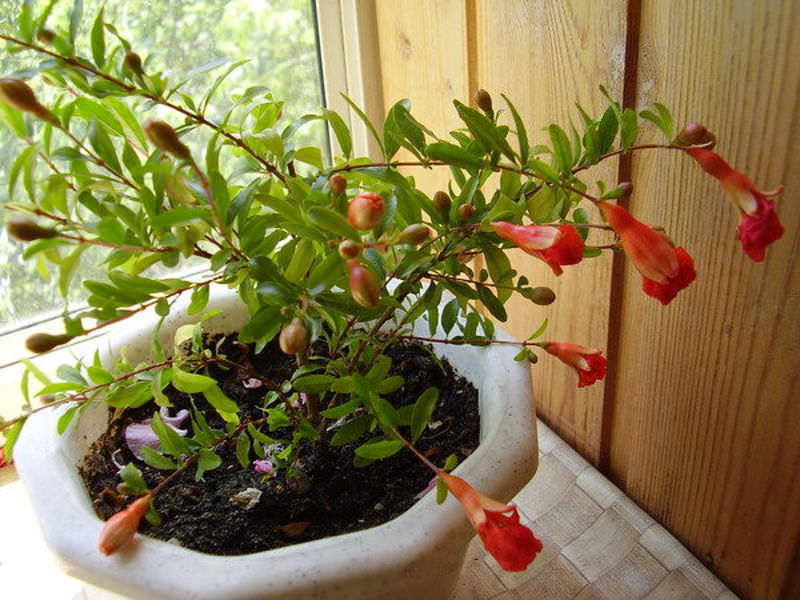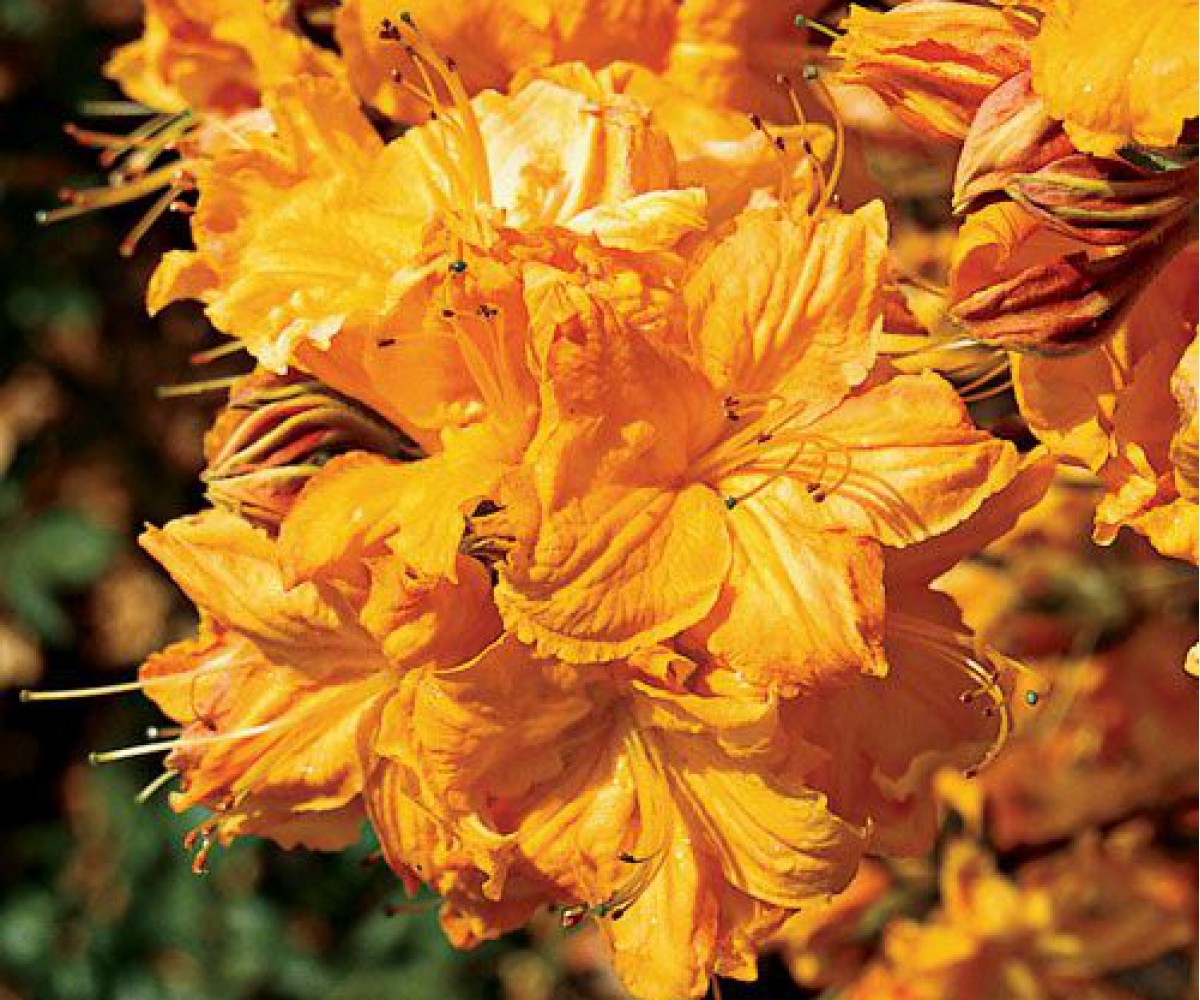The popular pomegranate tree, oddly enough, can be grown at home. But in such a situation, there is no need to hope for full-fledged fruits, since the plant will primarily perform decorative functions. For the purpose of growing at home, plants of a dwarf variety are better suited.
The dwarf grant variety is an exotic plant, but unpretentious and therefore perfect for growing at home. In the open field, a shrub plant can grow in tropics or subtropics. On the territory of our state, the plant is grown on window sills and in greenhouses in special containers or flower pots.
According to legend, garnet was brought to us from Carthage and was called the "Punic apple". The wife of the sun god, the Hero, presented the fruit as an emblem of marriage. The Greeks believed that pomegranate fruits symbolized fertility, and the ancient Persians personified it with passionate love. But whatever the pomegranate is associated with in different countries, its beneficial properties are familiar to everyone.
Content
How to grow pomegranate at home?
If a home grower decided to grow pomegranates on his windowsill, then he will be very pleased with the ease of care and planting of an ornamental plant. The only important thing to understand is that if you want to get tasty fruits in addition to enjoying the decorative beauty of the plant, then it is not recommended to grow an edible fruit from the seed. In such a situation, it is advisable to plant a dwarf pomegranate with cuttings.
A convenient material for planting is a stalk on which there is 6-8 buds and mature wood... The sprout is cut at an oblique angle and must have a smooth surface, for which the cut is made with a sharp blade or scalpel. Such a cutting takes root easily and quickly, especially if it is placed in water in which the agent for stimulating root growth is diluted for 6 hours. From the first days after planting, the plant does not require special care measures. The main thing is to prepare a fertile soil composition.
Temperature indicators, soil and feeding
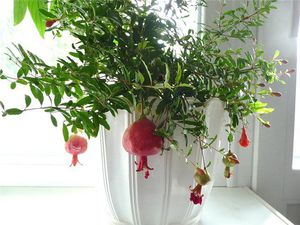 Indoor pomegranate is demanding on temperature conditions, especially at the time of flowering. The plant feels great when the indoor temperature slightly exceeds +20 ° C. If the temperature in the room is higher than +25 ° C, foliage may fallcausing inhibition in the development of the grant. In order to reduce the temperature, spraying the foliage with cool water is suitable.
Indoor pomegranate is demanding on temperature conditions, especially at the time of flowering. The plant feels great when the indoor temperature slightly exceeds +20 ° C. If the temperature in the room is higher than +25 ° C, foliage may fallcausing inhibition in the development of the grant. In order to reduce the temperature, spraying the foliage with cool water is suitable.
In order for the fruits of the plant to ripen qualitatively in the autumn, the pomegranate must be taken out to the balcony where the temperature will be + 14-16 ° C. During the period when the plant is at rest - from November to March, it is better to put the pomegranate pot on an unheated windowsill, where the temperature will not be higher than + 10-12 ° C.The minimum temperature that a houseplant can withstand is -5 ° C. A further decrease in temperature can lead to the death of the shrub.
Despite the fact that a dwarf plant grows in its usual environment in poor soil without moisture, at home, he will need a high-quality enriched drained soil. To create favorable conditions for growing decorative pomegranates, it is better to use the following soil mixtures:
- ½ part of sod land, diluted with 25% leaf humus and the same amount of sand;
- ¼ part of loam and peat, supplemented by sand;
- clay-sod soil composition in the volume of 2 parts, 1 part of leaf land and in the same volumes of humus and sand.
Indoor pomegranate needs to be fed at least 2 times a month. In the spring, it is better to use fertilizers containing nitrogen. At the time when pomegranate flowers appear on the plant, phosphorus fertilizer is used, and with the onset of autumn - potassium fertilizer. Fertilizer is applied to wet soil in cloudy weather. With the onset of autumn, the frequency of dressing decreases significantly, as does the temperature in the room where the home pomegranate is located. This allows the plant to be prepared for winter.
Plant care at home
Home-grown decorative pomegranate is already after 2 years it releases the first flowers, and with proper care it can bear fruit. And despite the fact that the plant is unpretentious in terms of care, you need to know some of the nuances of growing pomegranates on the windowsill:
 For planting a decorative tree, it is better to choose a narrow flowerpot. This allows for abundant fruiting.
For planting a decorative tree, it is better to choose a narrow flowerpot. This allows for abundant fruiting.- Since the natural habitat of the pomegranate is rocky slopes, there is no need to use too fertile soil in the conditions of an apartment.
- It is important to regularly and abundantly water the dwarf pomegranate, but very waterlogged soil is not suitable for the plant. Therefore, the plant is watered only when the upper layers of the soil are well dried. And in the spring and summer, it is advisable to use liquid top dressing.
- Only young pomegranates need to be replanted annually. A transplant once every four years is quite enough for an adult plant.
- Since the plant is a deciduous crop, after the leaves fall, it is moved to a cool room.
Such completely unpretentious plantgrown at home, during the growing season must travel to different rooms with different temperature regimes.
How is the crown of a bush formed?
When growing a tree on your own, its crown can be easily formed, embodying your most bizarre fantasies. To this end, home-grown pomegranates are regularly pruned from the first year of growth. Shearing the plant forms a rather lush crown with a large number of skeletal branches. Pruning is best done in February, which allows with the onset of spring to get new shoots capable of blooming and even bearing fruit. When shaping the crown, it is important to take into account that it is advisable to completely remove the weakened shoots, and cut the rest in half.
Nuances of reproduction of pomegranate seeds
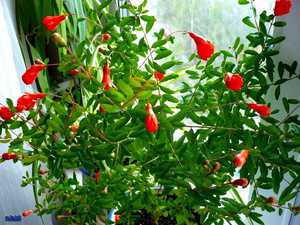 A houseplant such as pomegranate can propagate both by cuttings and by seeds. For seed propagation, it is better to use seed from specialized stores. Growing a houseplant from seeds purchased from a gardening store - the first flowers may appear in the first year, and fruiting 2-3 years after planting the pomegranate.
A houseplant such as pomegranate can propagate both by cuttings and by seeds. For seed propagation, it is better to use seed from specialized stores. Growing a houseplant from seeds purchased from a gardening store - the first flowers may appear in the first year, and fruiting 2-3 years after planting the pomegranate.
Naturally, as seed you can use seeds from a fresh fruit, which do not lose the germination quality within six months. Seeds are suitable only from large and fully ripe fruits. Sowing of the plant is carried out in April under glass, to a depth of half a centimeter. For fast germination of seeds, it is important to maintain a temperature regime within + 25-27 ° C.With the onset of the growth phase, when 2-3 leaves appear, the strongest shoots are transplanted into a separate container. During the growth of seedlings, they require proper care, which means maintaining a comfortable temperature and regular watering.
Houseplant propagation by cuttings
When propagating an exotic plant, it is important observe the following simple rules.
- The stalk is taken from an adult houseplant that has borne fruit several times.
- In the summer period, it is advisable to use semi-lignified shoots, and with the onset of winter, completely lignified shoots.
- Cuttings are prepared with 4–6 buds, and the lower part is planted at a certain angle in moist soil, consisting of sand and peat, mixed in equal proportions, to a depth of no more than 3 centimeters.
- The cuttings are covered with a cut-necked plastic bottle or glass jar.
- Shoots are kept in a humid environment and are regularly ventilated.
- Before direct planting, the cutting is processed by the rooting machine.
After 3 months, the matured seedlings are transplanted into separate pots. Flowering comes very quickly, but in the first year, flowers are recommended to be completely cut off.
Diseases encountered when growing pomegranate
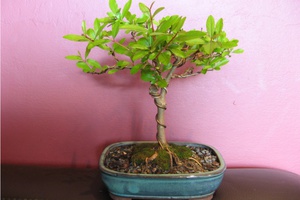 Despite all the unpretentiousness of the plant, even in an apartment, it is susceptible to the development of various diseases, the most common of which is the spider mite. To combat the pest, the pomegranate is periodically sprayed with garlic tincture. But it is important during the procedure to protect the soil with a film.
Despite all the unpretentiousness of the plant, even in an apartment, it is susceptible to the development of various diseases, the most common of which is the spider mite. To combat the pest, the pomegranate is periodically sprayed with garlic tincture. But it is important during the procedure to protect the soil with a film.
If during the growing season yellowing and foliage is observed, then most likely the plant is affected by the whitefly, which is fed by pomegranate juice. To combat the pest, you can use shop agent "Derris", which is applied several times for the best effect.
Abundant flowering is a guarantee of fruiting
A plant properly grown at home, both from the seed and from the cuttings, has flowers of different types - male predominant on pomegranate and female, most often found in inflorescences. They differ in their shape, which makes the plant outwardly even more attractive and exotic, because at this moment the shrub is covered with beautiful flowers of bright purple color with many stamens. The ease of caring for decorative pomegranates is also due to the lack of the need for additional pollination.
Those who want to get the maximum number of fruits from a plant should understand one minor subtlety that experienced specialists use when growing pomegranates. The trick is due to the fact that for watering during flowering you need to use cool water, the temperature of which must be within + 18–20 ° C. Also, so that the plant does not grow fat and does not release a huge number of male flowers, you need to use a small and narrow flower pot.
Many growers use another minor trick - reducing the amount of watering. But at the same time, it is important to exercise the utmost care and not overdo it so that the grenade does not die. It is better to donate several ovaries than to let the plant wither.
Professional advice
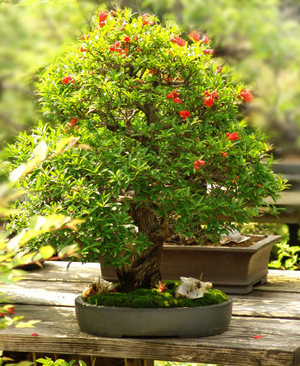 If the plant throws out a very large number of flowers, practically without forming fruits, you should pay attention to the pot in which it grows. It is necessary, as already mentioned many times, to use narrow container of small size... Also, during the wintering of the grant, you need to keep the tree in a fairly cool place. During fruiting, props are used to avoid breaking off branches under the weight of the crop.
If the plant throws out a very large number of flowers, practically without forming fruits, you should pay attention to the pot in which it grows. It is necessary, as already mentioned many times, to use narrow container of small size... Also, during the wintering of the grant, you need to keep the tree in a fairly cool place. During fruiting, props are used to avoid breaking off branches under the weight of the crop.
If brown spots appear on the leaves, then the plant does not have enough moisture. Therefore, it is necessary to reconsider the frequency or amount of watering. But at the time of fruit ripening, watering should be moderate to prevent cracking of the skin.The crown of the plant is formed only before the beginning of the growing season.
If the plant is planted not by cuttings, but by seeds, it is important choose bones with pulp... The dried seed loses the ability to germinate well. According to the advice of many experienced gardeners, before planting pomegranate directly, it is advisable to soak the seeds for several hours in warm milk or water with the addition of growth stimulants.
As you can see, it is not difficult to grow a decorative pomegranate at home. The main thing is to adhere to the advice of experts and an exotic tree will delight the grower for many years.
